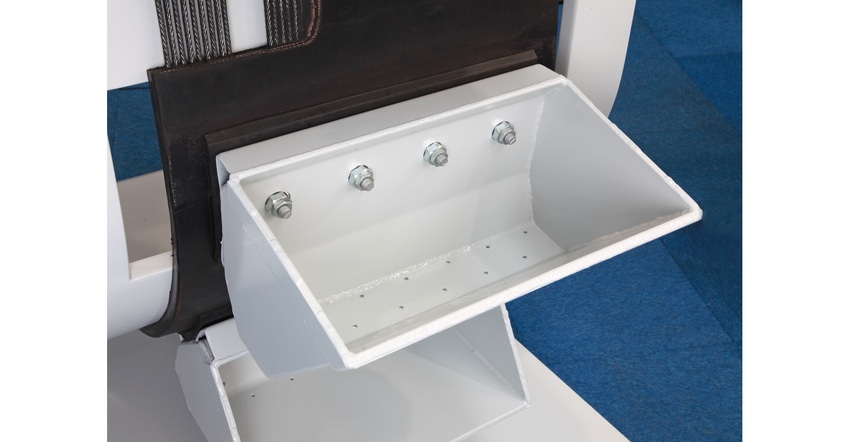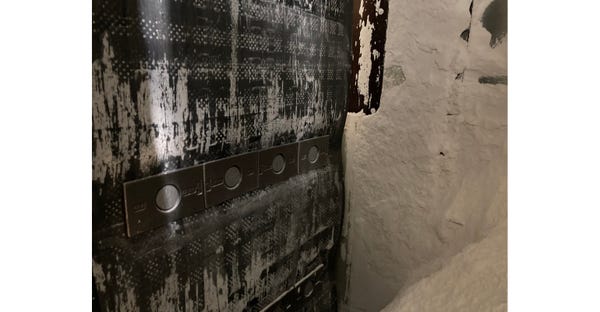Beumer Assists Cement Manufacturer in Modernization of Bucket Elevators
Bucket elevators were manufactured by another supplier
February 18, 2022

Outdated technologies often lead to increased maintenance, and that can rapidly become expensive. A cement plant owner faced this problem with his bucket elevators. An analysis carried out by the Beumer customer support team made things clear: It is not necessary to replace the whole systems, but only components. The service experts were able to modernize the bucket elevators and make them more efficient, even if the systems were not from Beumer.
"Right from the beginning, our three bucket elevators caused problems," said Frank Baumann, plant manager at a medium-sized cement company based in Erwitte, North Rhine-Westphalia, near Soest, Germany.
In 2014, the manufacturer also established a plant in Duisburg. "Here, we produce blast furnace cement, using a central chain bucket elevator as circulation bucket elevator for the vertical mill and two belt bucket elevators for the silo feeding," said Baumann.
The central chain bucket elevator on the vertical mill was unusually loud right from the beginning and there was also an immense chain vibration of more than 200 mm. Although the original supplier made several improvements, a high level of wear and tear was evident after only a short running time. "We had to service the systems more and more frequently," said Baumann. This was expensive for two reasons: downtime and spare parts.
Frequent Downtime, High Costs
Due to the frequent downtime on the vertical mill circulation bucket elevator, Beumer Group was contacted in 2018. The system supplier not only supplies bucket elevators and modernizes them if necessary, but also optimizes existing systems of other suppliers. "In cases like this, operators of cement plants are often faced with the question of whether a completely new plant or a possible conversion would be the more economical and targeted measure," explained Marina Papenkort, area sales manager in the customer support division at Beumer Group. "With our customer support, we help our customers to fulfil future performance and technology requirements in a cost-efficient way in the context of modernizations and modifications. Typical challenges of our customers include performance improvements, adaptations to modified process parameters, new materials, optimization of availability and extension of the maintenance cycles, designs easy to maintain as well as reduced noise levels." In addition, all new developments with regard to Industry 4.0, such as belt monitoring or continuous temperature monitoring, are included in the modifications. Beumer Group offers everything from one single source, from technical dimensioning to assembly on site. The advantage is to have only one contact and thus to benefit from reduced organizational and coordination expenses.
Profitability and especially availability play a crucial role for customers, because modifications are often an interesting alternative to new constructions. In case of modernization measures, as many components and structures as possible are kept - in many cases also the steel structure. This alone reduces material costs by approximately 25% compared to a new construction. In the case of this company, the bucket elevator head, the chimneys, the drive unit, and the bucket elevator boot could be reused. "In addition, the assembly effort is lower, and so the downtime is usually much shorter," explained Papenkort. This leads to a faster return on investment compared to a new construction.
Heavy Duty for Coarse-Grained Material
"We retrofitted the central chain bucket elevator to a high-capacity belt bucket elevator type HD (heavy duty)," said Papenkort. Belts with wire-free zones, and to which the buckets are fastened, are used for this type of bucket elevators just as with all Beumer belt bucket elevators. In case of products from competitors, often the steel cords are cut through when mounting the buckets. The steel cords are no longer covered, which might result in moisture penetration and, as a consequence, lead to corrosion and damaged supporting cords. "That's not the case with our systems. The tensile strength of the bucket elevator belt is completely kept," explained Papenkort.
Another important factor is the belt clamping connection. The rubber of the steel cord ends is first removed on all Beumer steel cord belts. The technicians divide the ends into individual strands in the U-shaped part of the belt clamping connection, twist and cast it with white metal. "Thus, the customer benefits from a huge time advantage," said Papenkort. "After casting, the junction is completely cured after a very short time and the belt is ready for use."
Steady Running of the Belt
In order to enable a steady running of the belt and to extend the service life in view of the abrasive material, the Beumer team exchanged the existing segmented laggings of the drive pulley by specially adapted ones equipped with ceramic. These are crowned for a steady straight run. The design--which is easy to maintain--enables quick replacement of the single segments of the segmented lagging through the inspection hatches. It is no longer necessary to exchange the complete drive pulley. The segmented laggings are rubberized, with linings made of full ceramics or steel. The choice depends on the material conveyed.
The buckets are adapted to the crowned shape of the drive pulley and thus lie flat on, which considerably increases the service life of the belt. Their shape allows for smoother running and less noise generation. Depending on the intended use, the operator receives the buckets in the best suited design. For example, they can have a rubber bottom or be made of high-quality steel. The proven Beumer HD technology impresses with a special bucket connection: In order to prevent coarse-grained material from penetrating between bucket and belt, the bucket is provided with an elongated back plate that can be mounted flush to the bucket elevator belt. In addition, with the HD technology, the buckets are mounted firmly to the back of the belt with forged segments and screws. "All the screws would have to get lost for a bucket to tear out," explained Papenkort.

To Keep Everything Running Straight
In order to achieve a permanently correct tensioning of the belt, Beumer mounted an external parallel take-up device without product contact in Duisburg, which ensures that the take-up pulley is limited to parallel movement. The tension bearing is designed as inner bearing in a completely encapsulated construction. The bearing housings are filled with oil. "A part of our HD technology is the cage-type foot pulley which is easy to maintain. The bars are hardened due to the abrasive material conveyed and screwed into the cage-type foot pulley to enable a rapid replacement. The take-up pulley is equipped with a double deflection cone, which reliably prevents damage to the belt caused by jammed bulk materials," explained Papenkort.
Follow-Up Order
"This modification enabled us to increase the availability of our vertical mill circulation bucket elevator and to be more competitive on the long term," said Baumann. "Compared to a new investment, it was possible to reduce our costs and we were operating faster. At the beginning, we had to convince ourselves more than once that the retrofitted circulation bucket elevator was in operation, because the noise level had changed drastically and we were not familiar with the smooth running from the previous chain bucket elevator."
The company was so enthusiast about the retrofitting that it commissioned Beumer Group to optimize the other two bucket elevators with regard to the conveying capacity. Also, the operator complained about continuous off-tracking, buckets hitting the shaft casing, and difficult maintenance conditions. "In addition, we wanted to further increase the throughput of the mill and were therefore interested in greater flexibility regarding the conveying capacity of the bucket elevators," explained Baumann.
In 2020, the customer support of the system supplier also solved this problem. "We are completely satisfied," said Baumann. "In the course of the retrofitting, we could also reduce the energy consumption of the bucket elevators."
About the Author(s)
You May Also Like




